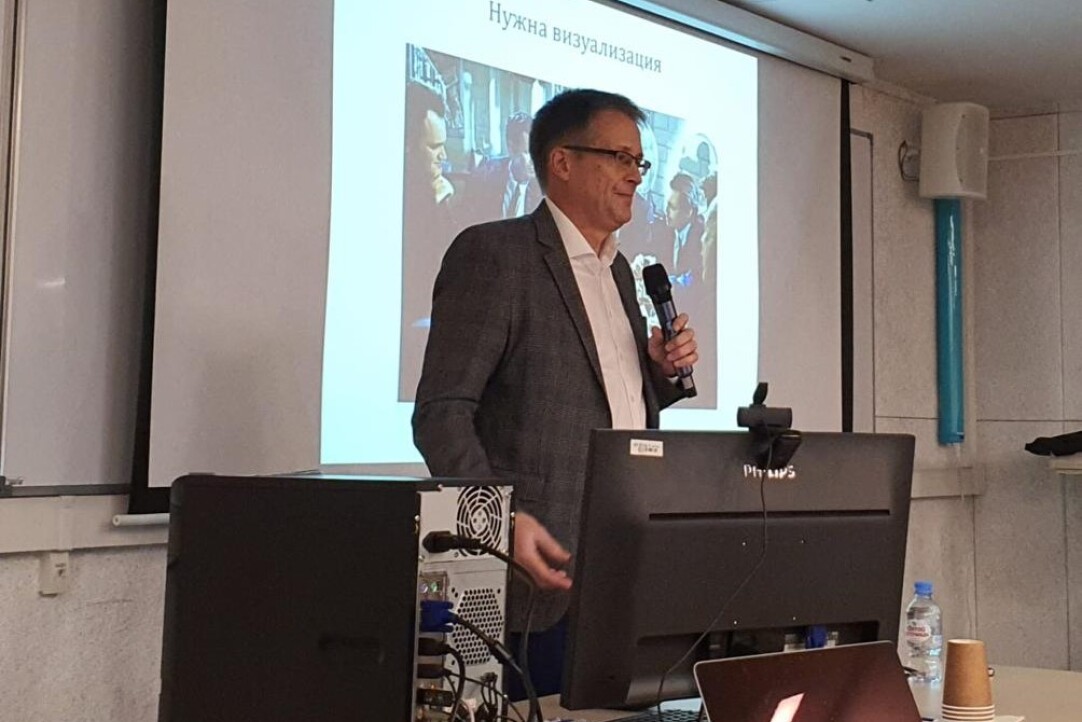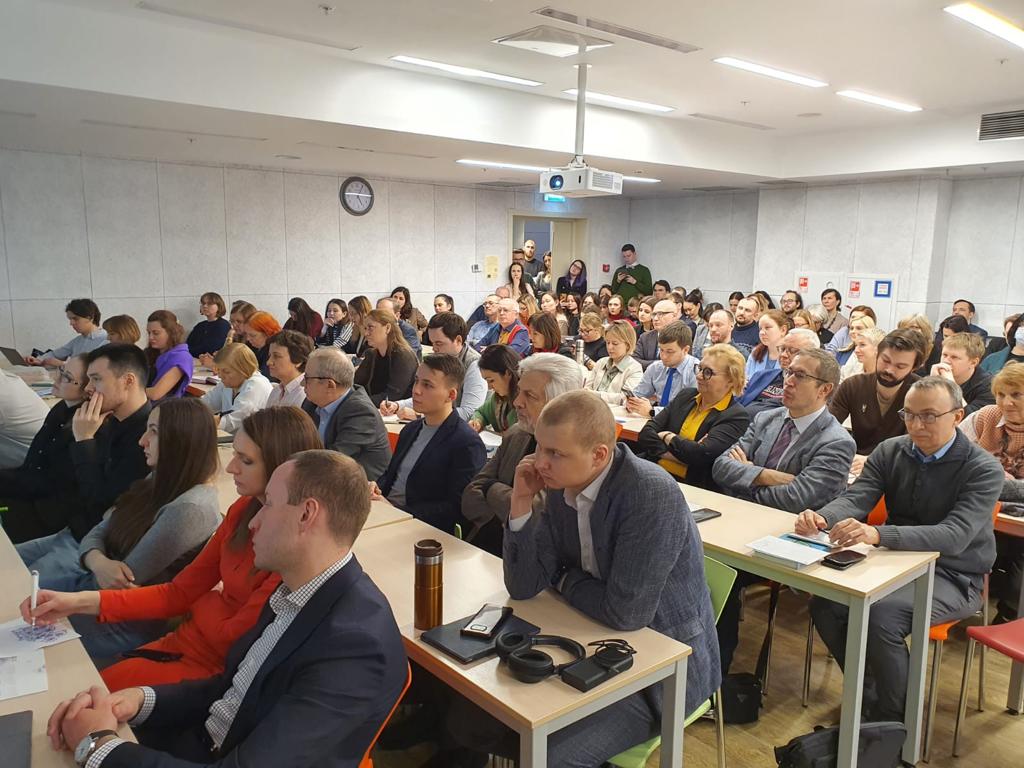‘Talk about Complex Matters in a Simple Way’: Vadim Radaev on How to Hold an Audience’s Attention

As part of the Teach for HSE project, HSE University First Vice Rector Vadim Radaev shared his pedagogical findings with faculty members. Leaning upon his experience, that of teachers, and conversations with colleagues, he answered questions about different aspects of holding the attention of a student audience and gave examples of effective methods and techniques.
Holding attention is quickly becoming a major problem for educators. While in the past, many students chatted in class and had to be separated from each other, now they are more likely to sit quietly. However, this does not make things easier, as most of them are more interested in their smartphone and laptop screens.
Teachers today are not a source of critical knowledge; according to Vadim Radaev's observations, many believe that such information can be googled anytime. In these conditions, modern educators must possess a wide range of lifehacks—tricks to attract and keep the audience's attention.
One simple—but necessary—method is eye contact.
During class, the teacher must see each and every person. If this is impossible to do while seated, they should stand or move around the room.
They should not just read a text, stare at the wall, or look at one student the whole time. The teacher should address everyone, and each student should feel that they being addressed individually. One must at least try to achieve that, explains Vadim Radaev.
What can be done if a student still talks and distracts others? According to the speaker, a reprimand is not the best policy in this case. It is better to begin by simply looking at the student in question while continuing the lecture. If they keep talking, the teacher can approach them, and if this does not work, the teacher can simply stand still and keep quiet. Another thing to do is to ask the student if everything is clear to them (if there is anything that needs to be repeated). The last resort is to ask the student to leave the room; however, Vadim Radaev has never done so throughout his many years of teaching.

In situations where students are distracted by their gadgets and have stopped looking at the teacher, the role of eye contact decreases and gives way to the role of the voice. Vadim Radaev believes that what matters most is not speaking volume (which is also enhanced by the microphone), but constant fluctuation, avoiding monotonous speech, changing the volume and intonation, and speech accentuation. The expected speech tempo should also change. In the past, teachers could talk slowly, as if pondering as they speak, but life has become faster and not all students are ready to wait till the end of such musings. Of course, one should not hurry, but the overall speed of speech should be faster.
If the lecture is long, the teacher should use different kinds of intermissions. ‘When I studied at Moscow State University, we had a course on national planning with one very famous woman, a professor. It was hard to think of a subject more boring than that, but she paused in the middle of each lecture to tell a frivolous joke unrelated to planning, and kept us guessing what joke she would tell next time. And I sometimes tell tales—short true stories, but I believe they should be related to the topic of the class and work for it,’ Vadim Radaev shared.
When asked about the line between the scientific part of a lecture and the popularisation of scientific ideas, the speaker replied that content must be structured, reasoned and precise, and the form must be as clear and easy to perceive as possible. ‘It is better to talk about complex matters in a simple way. If we use complicated language for complicated issues, it means we do not fully understand those issues,’ he believes.
Content visualisation matters to modern students, because they belong more to visual culture than text culture, and they directly ask teachers to give them less text and more pictures and infographics.
Moving pictures are even better. One can start a class with a short video that serves as an entry point that grabs students' attention by dealing with something familiar to them. ‘For example, I begin one seminar in the course on Economic Sociology with a five-minute clip from Tarantino's film Reservoir Dogs, and then make a smooth transition to the structure of human motivation, because the clip is about that,’ Vadim Radaev says.

When asked about how a teacher should look in order to keep the audience focused on their words, not their appearance, he suggested that a teacher's visual appeal should be just another tool for attracting the audience's attention—and not an obstacle to it. Of course, one must not look like a sexual object, but one should avoid untidiness and sloppiness (which is sometimes a deliberate affectation). After all, every teacher represents the university and should show respect to the profession and other people.
According to Vadim Radaev, humour is appropriate in class, but one must consider the context and the generation gap.
Older generations may have a different culture of jokes and perception of humour than young people, and people should be mindful of the potential to cause offence.
The speaker believes that the lecture format has not disappeared and will not disappear, but one should encourage student participation in any class, stir up questions, and answer them in the course of the lecture. It is even possible to build an entire speech on questions, including those received in advance, while mentioning the people who asked them (as done during this lecture). The interactive formats used by Vadim Radaev include debates in small groups, where students prepare in advance and discuss a complex problem with no obvious solution, as well as discussions of other people's projects, where people can criticise, ask questions, give advice, and help each other.

A separate problem that the speaker focused on was keeping students' attention in an online format. This is more difficult for educators, as there is no live contact, involvement or empathy, and not enough audience control. The only thing left is to enhance emotionality, use interactive formats, be gentle but persistent in asking all the students to switch on their cameras, wait for it to happen, and convince the remaining ones to appear on the screen. ‘It is not just a question of effectiveness and engagement; it is a question of academic ethics and mutual respect,’ Vadim Radaev believes.
When asked about the kind of content that attracts the audience's attention, the speaker explained that students value content that they consider useful or potentially useful for their work in the near future. But the trouble is that they do not always know what this useful content should be, so the educator's task is to explain the essence and importance of general academic skills, which are actually instrumental as well. But, while specific instrumental skills are useful in certain situations, and not in others, academic skills are useful everywhere. ‘Students will understand it later, but we have to try and explain it now,’ Vadim Radaev concludes.
In the course of the lecture, the first vice rector answered other questions related, in particular, to political correctness in class, the teacher's right to digress to the news agenda, teaching in English, the use of ChatGPT by students, the optimal duration of lectures and seminars, and more.
Vadim Radaev outlined his thoughts on teaching in modern conditions and ways of keeping the attention of the younger generation in his book Teaching in Crisis, published by the HSE Publishing House in 2022. The second edition is set to be published this year.
A recording of the lecture is available here (in Russian).
See also:
HSE University Launches Digital Teaching Consultants Project
In May 2021, 25 digital teaching consultants began work at all campuses of HSE University. Their task is to help colleagues teach effectively online and make use of digital technology in their teaching. All consultants passed a selection by the Expert Committee. Below, HSE News Service tells us about the participants of the new Teach for HSE project.
Teach for HSE Helps Lecturers Apply 3D Modeling to Teaching
In December, the Teach for HSE project held the master class ‘From Photography to 3D-Model: 3D-Modeling Technology in Teaching and Project Activity’ for HSE lecturers. The master class was delivered online by Iliana Ismakaeva, lecturer at the Faculty of Social Sciences and Humanities at HSE – Perm and winner of the spring competition of the Fund for Educational Innovation.


